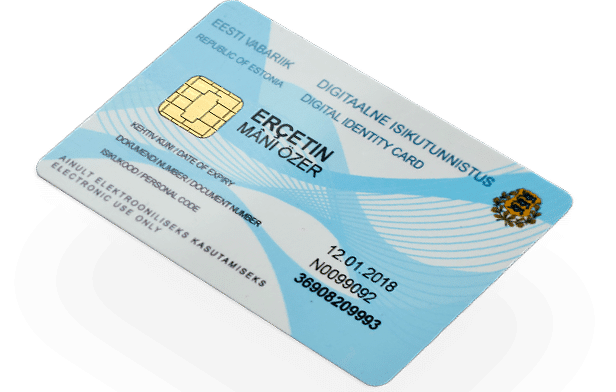- A Digital Nation
- Start an E.U. Business
- How to Get Estonia E-Residency
- Estcoin
- Blockchain Applications
- Conclusion
Estonia is a small Baltic nation of 1.3 million people, but they’re leading a digital revolution in governance with the Estonia e-Residency program. It’s a country where the state drives technological innovation, not just the private sector. Since 2007, they’ve been working on proposals to digitize identity and citizenship. Today, every citizen of Estonia has their own ID card and PIN that links with their digital identity.
Recently, in 2015, Estonia opened this digital identity system up to non-citizens. Anyone in the world can now apply to become an e-resident of Estonia. Being an e-resident doesn’t confer citizenship, but it does allow you to open a bank account and start a business in Estonia. In the future, Estonia hopes to expand the capabilities of e-residency. In this article, we’ll look at what e-residency entails, how to become an e-resident, and Estonia’s future plans for digital identity and blockchain-based governance.
A Digital Nation
Estonia is well-known in the region as a tech and startup hub. They’ve been at the forefront of digitizing state services over the past few years. U.S. President Barack Obama, when visiting Estonia, remarked,
“With their digital IDs, Estonians can use their smartphones to get just about anything done online, from their children’s grades to their health records … I should have called the Estonians when we were setting up our health care website.”
Citizens can use their ID cards to vote online and all government records are accessible online. Moreover, Estonian citizens control their data. They can choose to restrict access to various information in their personal profiles.
The new e-residency program opens some of the functionality of citizen IDs to the entire world. The Estonian government calls the Estonia e-residency program “a new digital nation.” They anticipate that the number of e-residents will one day surpass the number of actual citizens in Estonia.
Blockchain underpins all of Estonia’s digital identity services. They’re looking at ways to expand blockchain to store data and verify contracts autonomously, without the need for a central authority. For instance, you can currently use your Estonian ID, in combination with a PIN, to digitally sign documents with your unique, hashed signature.
Start an E.U. Business
The main benefit of becoming an Estonian e-resident is the ability to start an Estonian business. Estonia is a member of the European Union, so this business, once established, would be able to transact across Europe. Actually establishing the business is more complicated than just paying a fee. You’ll need an Estonian address to create the business, and you’ll need to physically go to Estonia once to set up a bank account.
Once you do, however, it’s possible to entirely administer your business and bank account online. You can run your business from anywhere in the world, including digitally signing any Estonian contracts or applications.
[thrive_leads id=’5219′]
How to Get Estonia E-Residency
So, you’re interested in becoming an e-resident?
Let’s be clear, it likely won’t solve all your problems. The abilities of e-residents are very limited. If you’re from a developing country or do a lot of business in the European Union, however, it could be a very profitable decision. If you want to live in Estonia, however, you’ll need to go through different residency requirements.
To become an Estonian e-resident, you’ll need:
- A copy of your current, government-issued ID
- A passport-style photo
- A motivation statement of why you want to become an e-resident
- A Visa/Mastercard to pay the 100 euro fee
That’s it. The application itself is online and fairly simple. It may take a little while to process. Once it does, you’ll have to visit the nearest Estonian consulate in-person. This could be far away from you, making this another hurdle to getting your identity card. For instance, the only office in the United States is in New York City.
After you visit the consulate, you’ll leave with a chip-included digital residency card that you can plug into a USB-based card reader to access government services and sign documents.
Estcoin
Recently, Estonia made waves when they announced that they’re exploring options for a national cryptocurrency. It has since earned the name “estcoin.” The Managing Director of the Estonia e-Residency program, Kaspar Korjus recently wrote about the motivations behind the coin,
“The community estcoin would be structured to support the objective of growing our new digital nation by incentivizing more people around the world to apply for and make greater use of e-Residency.”
The program hopes to encourage startups to use Estonia e-Residency as a platform for launching trusted, compliant ICOs.
In addition, estcoin will include other token types that assist with identity and access permissions that can’t be traded. Another estcoin will be pegged to the euro to provide the stability of fiat money. It wouldn’t be an alternative to the euro, but a supplement for digital transactions.
Ethereum’s Vitalik Buterin commented on Estonia’s plans,
“[I]f these estcoins are issued on top of a blockchain (they could possibly be issued in multiple formats at the same time, nothing wrong with this) then it would become easy and convenient to use them inside of smart contracts and other applications.”
Blockchain Applications
Estonia is pioneering the use of blockchain for securing citizen information. They already have systems in place and under development to leverage blockchain in many aspects of everyday life.
Health records can now be secured digitally, and Estonians have control over what records their doctors can see.
Grades and educational attainment certification are now on a digital ledger as well, opening the possibility of sharing educational attainment information with employers.
Estonians can vote digitally online using their unique ID cards. They simply log in and place their votes from anywhere in the world.
Additionally, the government allows testing of level three autonomous cars (with humans behind the steering wheel watching the car) on all roads in Estonia. They’re already thinking about ways to encourage level five (fully autonomous) driving while maintaining safety regulations.
Conclusion
Estonia is leading the way for digital, blockchain-based governance. It’s an example of what’s possible when the state is willing to lead innovation, instead of playing catch up to the private sector. Expect to see many more governments following Estonia’s lead over the coming years.
Never Miss Another Opportunity! Get hand selected news & info from our Crypto Experts so you can make educated, informed decisions that directly affect your crypto profits. Subscribe to CoinCentral free newsletter now.












